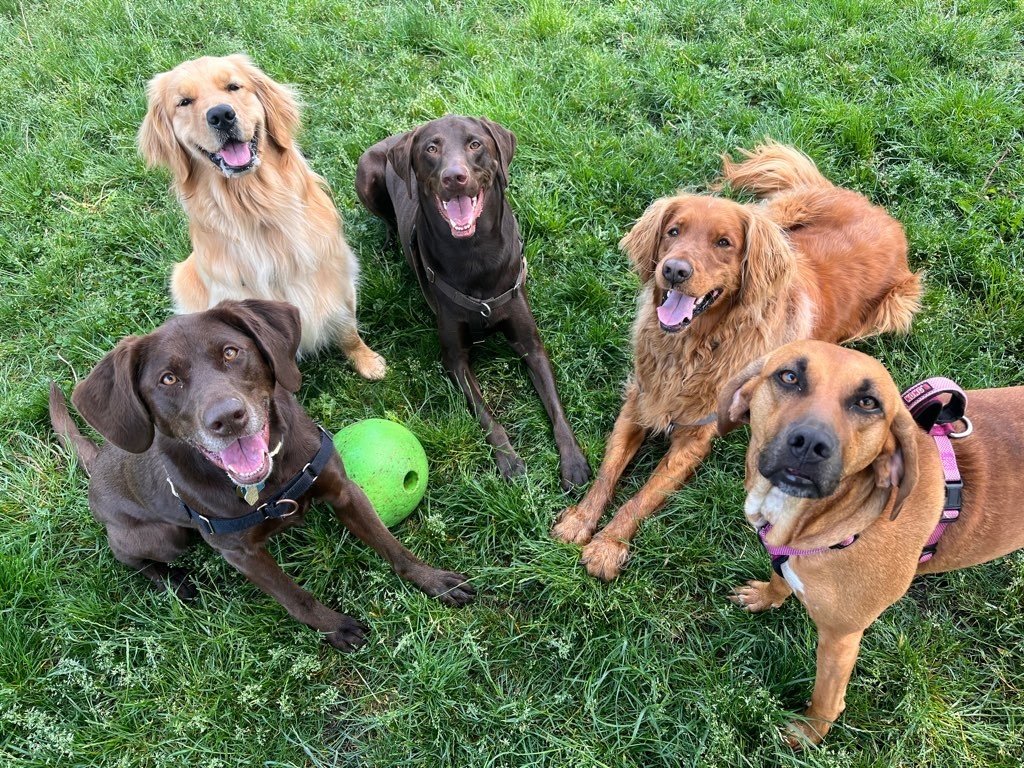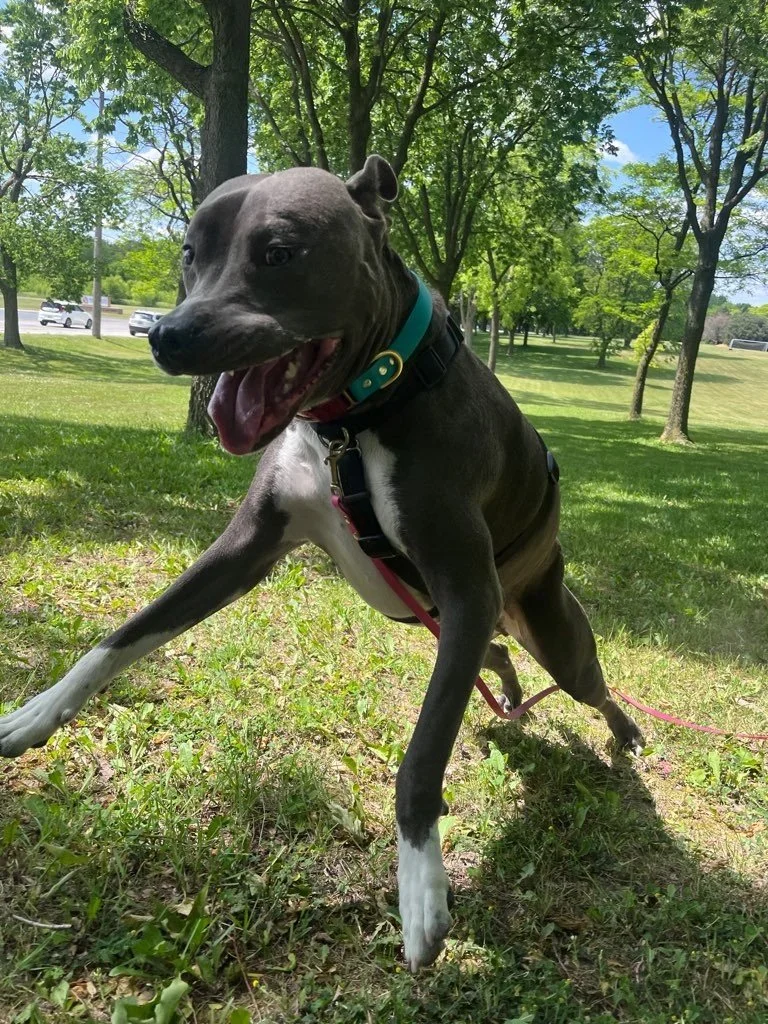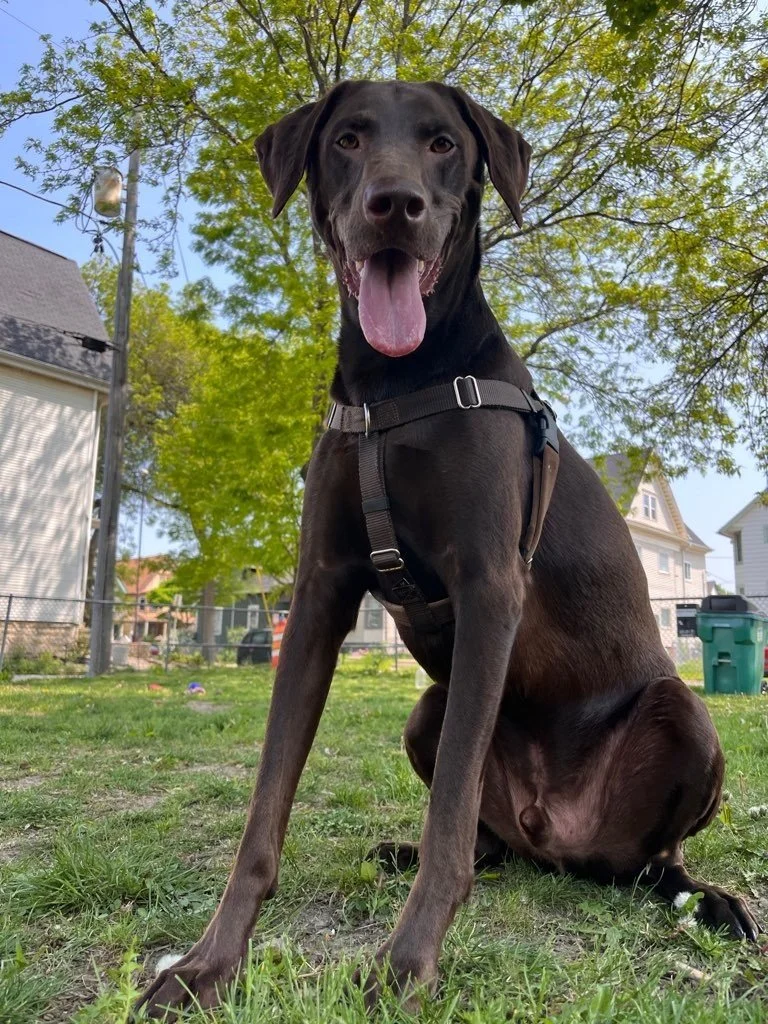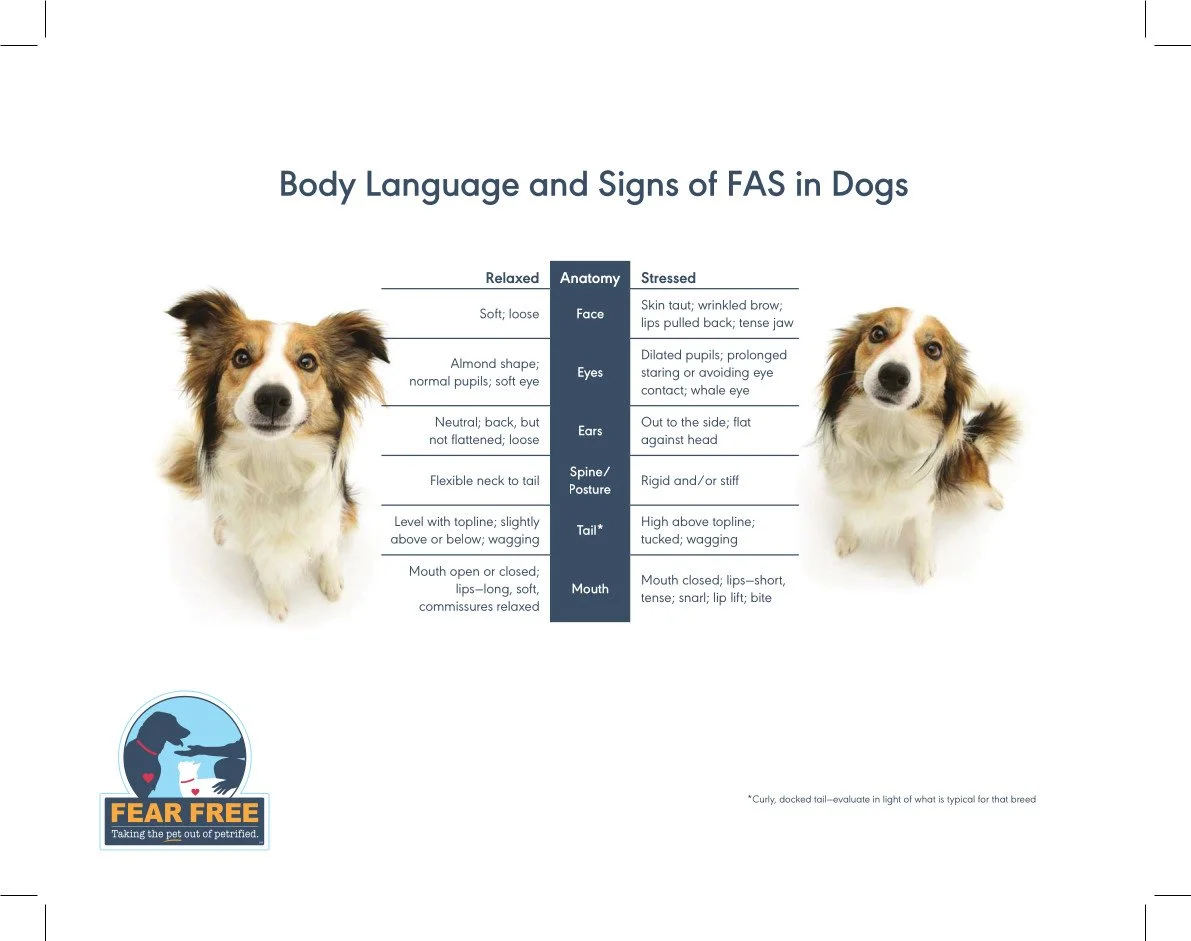Hello fellow dog enthusiasts, it’s Marsha and this week I’ll be covering dog body language!
Dogs have a remarkable ability to communicate with us, not through words, but through their body language. Understanding dog body language is key for building a strong bond with our four-legged friends. By interpreting their signals correctly, we can better understand their emotions, needs, and desires. Continue reading as we delve deeper into the fascinating world of dog body language, exploring the intricacies of facial expressions, postures, movements, and vocalizations.
What is Dog Body Language?
Dog body language is a complex and nuanced form of non-verbal communication that dogs use to express themselves. It involves a combination of physical cues, such as facial expressions, postures, movements, and vocalizations. Each of these elements conveys important information about a dog's emotional state, intentions, and well-being.
Barley’s facial expression tells us that he does not enjoy walks in the rain
Facial Expressions
A dog's facial expressions play an important role in understanding their emotions and intentions. Just like humans, dogs can convey a wide range of emotions through their facial muscles. When a dog is relaxed and content, their facial muscles tend to be relaxed as well. Soft eyes, which appear gentle and calm, reflect a sense of ease and tranquility. The slight opening of the mouth, often accompanied by a soft pant, indicates a comfortable and at ease demeanor.
However, certain facial expressions can signify different emotions. Raised eyebrows or a furrowed forehead suggest confusion or concern. This can be seen when a dog is trying to understand a new situation or is unsure about something happening in their environment. These expressions often indicate a need for reassurance or clarification from their human companions.
On the other hand, a tense mouth, bared teeth, or a wrinkled muzzle are clear signs of fear or aggression. A dog may display these expressions when they feel threatened, cornered, or are in a defensive state. These facial cues serve as warnings to communicate that the dog is uncomfortable and may react defensively if the perceived threat persists.
Marley’s posture shows she’s confident and ready to play
Postures
Postures are a fundamental aspect of dog body language and serve as powerful indicators of their emotional state. A relaxed dog often adopts a neutral body posture, standing with their weight evenly distributed on all four legs. Their muscles are relaxed, and their body appears loose and at ease. This posture conveys a sense of contentment and confidence.
An alert and interested dog, on the other hand, exhibits a different posture. They may lean forward slightly, with their head raised and ears perked up. This forward-leaning stance indicates their attentiveness and engagement with their surroundings. It signifies curiosity and a readiness to respond to stimuli.
Conversely, a fearful or submissive dog displays a distinct posture that reflects their unease. They may crouch low to the ground, with their tail tucked between their legs and their ears pulled back against their head. This posture is an instinctual attempt to appear smaller and less threatening. It conveys their fear and submission, signaling a desire to avoid confrontation or potential harm.
Ca$h’s movement expresses his excitement with zoomies
Movements
The movements of a dog offer valuable clues about their emotional state and intentions. One of the most recognizable movements is the wagging tail, often associated with happiness. However, it's vital to pay attention to the context and intensity of the wag. A loose and wide wag typically indicates a friendly and approachable demeanor, while a stiff or high-held tail can signal tension or potential aggression. It's important to consider other accompanying body language cues when interpreting the meaning behind a wagging tail.
The speed and style of a dog's movements also provide insights into their emotions. Quick, bouncy movements are commonly observed when dogs are excited or playful. They may jump, hop, or engage in zoomies, expressing their joy and enthusiasm. Conversely, slow and deliberate movements may indicate caution or wariness. A dog moving slowly may be assessing their surroundings, evaluating potential threats, or displaying a reserved disposition.
Vocalizations
The way dogs vocalize play a significant role in their communication, allowing them to express their needs, emotions, and intentions. Among the various vocalizations, barking is the most prominent. Dogs use different tones and pitches to convey different messages. A playful bark often has a higher pitch and a rhythmic pattern, reflecting their excitement and eagerness to engage. In contrast, a warning bark tends to be lower and more intense, signaling a potential threat or the need to establish boundaries.
Growling is another vocalization that dogs employ to communicate. It can indicate discomfort, a desire to protect something or someone, or a warning to back off. The tone and intensity of the growl provide important cues about the dog's emotional state and level of perceived threat.
Whining or whimpering vocalizations typically indicate fear, stress, or a need for attention. These sounds are often associated with an appeal for comfort, reassurance, or a desire for social interaction. Dogs may use whining as a means to communicate their anxiety or discomfort in a particular situation.
Developing a Stronger Connection through Dog Body Language:
Observe and Learn
Taking the time to observe and understand your dog's body language is a crucial aspect of building a strong bond and effective communication with them. By paying attention to their facial expressions, body postures, and movements, you can gain valuable insights into their emotions, needs, and experiences. Each dog has their own unique communication style, and by observing them in various situations, you can start to recognize patterns and understand what different signals mean for your specific canine companion.
Noticing how different facial expressions, such as relaxed or tense muscles, soft or intense eyes, and open or closed mouth, correspond to different emotions will allow you to better gauge your dog's overall well-being and emotional state. Similarly, observing their body postures, whether it's a relaxed and loose body or a crouched and tucked tail, will provide clues about their comfort level and level of alertness. By watching their movements, you can also identify their excitement, caution, or need for attention. Are they bouncing with joy or moving slowly with hesitation? These cues can tell you a lot about their current mood and level of confidence.
With consistent observation and attention to detail, you'll gradually become more attuned to your dog's unique communication style. You'll develop an intuitive understanding of their needs, desires, and emotional state. This enhanced understanding will not only strengthen your bond but also enable you to respond appropriately to their needs, ensuring their well-being and happiness.
Remember that each dog is an individual, and while general body language guidelines are helpful, it's important to recognize the specific signals and nuances that are specific to your own furry family member. Building this level of communication and connection will deepen your relationship with your dog and create a harmonious and fulfilling partnership.
Context Matters
When it comes to interpreting dog body language, context plays a vital role in understanding the true meaning behind their signals. It's important to consider the entirety of the situation and look for patterns and combinations of signals to gain a comprehensive understanding of your dog's emotional state. Relying solely on a single signal may lead to misinterpretation.
For instance, the wagging tail is often associated with happiness, but its meaning can vary depending on other accompanying cues. A wagging tail alongside relaxed facial muscles, loose body posture, and a friendly demeanor generally indicates a happy and content dog. However, if a dog's tail is wagging while their body appears tense or their facial muscles are tight, it may suggest insecurity, caution, or a mixed emotional state.
By observing multiple signals together, you can form a more accurate understanding of your dog's overall emotional state. It's crucial to consider the combination of facial expressions, body postures, movements, and vocalizations to paint a clearer picture. Pay attention to the context in which these signals occur, such as the environment, interactions with other dogs or people, and any recent experiences or stimuli.
Understanding your dog's body language within its specific context allows you to respond appropriately and provide the necessary support. It enables you to recognize when your dog is comfortable, anxious, fearful, or in need of reassurance. By taking the time to observe and interpret their signals holistically, you can strengthen your bond with your dog and ensure their well-being in a variety of situations.
Tailor Your Approach
Once you have a good grasp of your dog's body language, it's essential to tailor your interactions to their individual needs and comfort level. Respect their boundaries and recognize when they may feel anxious, fearful, or overwhelmed. By doing so, you create a safe and supportive environment that fosters trust and understanding.
One way to tailor your approach is by providing positive reinforcement for desired behaviors. When your dog displays behaviors that align with their comfort and well-being, such as relaxed body language or friendly engagement, offer praise, treats, or affection. This positive reinforcement helps reinforce those behaviors and encourages your dog to continue engaging in them.
It's equally important to avoid forcing your dog into situations that make them uncomfortable or overwhelmed. Pushing them beyond their comfort zone can lead to heightened anxiety and potential negative associations. Instead, allow your dog to approach new experiences or interactions at their own pace. Provide them with opportunities to explore and adjust gradually, ensuring they feel safe and supported throughout the process.
Adapting your approach based on your dog's body language and needs also involves effective communication. Use calm and reassuring tones of voice, gentle movements, and clear signals to convey your intentions and establish a sense of trust. By respecting your dog's boundaries and responding sensitively to their signals, you demonstrate your understanding and consideration for their well-being.
Remember that each dog is unique, and their comfort zones may differ. Pay attention to their individual preferences and sensitivities. Through consistent observation, understanding, and tailored interactions, you can build a stronger bond with your dog and create an environment that nurtures their emotional health and overall happiness.
Seek Professional Guidance
If you find yourself uncertain about your dog's body language or facing specific behavioral challenges, it can be incredibly beneficial to seek professional guidance from a qualified dog trainer or behaviorist. These experts have extensive knowledge and experience in understanding dog behavior and can provide valuable insights into your dog's individual needs.
A professional dog trainer or behaviorist will assess your dog's body language, behaviors, and overall demeanor to gain a comprehensive understanding of their specific issues or challenges. They can help you interpret your dog's signals accurately and guide you in developing appropriate strategies to address any behavioral concerns.
Working with a professional allows for personalized advice and tailored solutions that take into account your dog's unique personality, history, and environment. They can provide practical training techniques, behavior modification plans, and management strategies to help address specific issues effectively.
Moreover, a professional's guidance can give you the confidence and support you need to navigate challenging situations. They can teach you how to effectively communicate with your dog, set clear boundaries, and reinforce positive behaviors. By learning from their expertise, you'll be better equipped to understand and respond to your dog's body language in a way that fosters a healthy and harmonious relationship.
Remember that seeking professional guidance doesn't imply a lack of capability or dedication as a dog owner. Rather, it demonstrates your commitment to providing the best care and support for your furry companion. With their specialized knowledge and guidance, a professional can help you navigate through any uncertainties or behavioral challenges, ultimately leading to a happier and more fulfilling relationship with your dog.
Decoding dog body language is an essential skill for every dog owner. By understanding the subtle cues conveyed through facial expressions, postures, movements, and vocalizations, we can deepen our connection with our furry companions. Paying attention to their body language allows us to respond appropriately to their needs and emotions. Remember, communication is a two-way street. By learning their language, we can forge stronger relationships and create a harmonious bond with our beloved dogs.












Discover the benefits and practical applications of choice-based dog training methods, also known as positive reinforcement or force-free training. Join us in exploring how giving your furry friend choices during training can lead to stronger skills and a more fulfilling and harmonious relationship for both you and your pup.